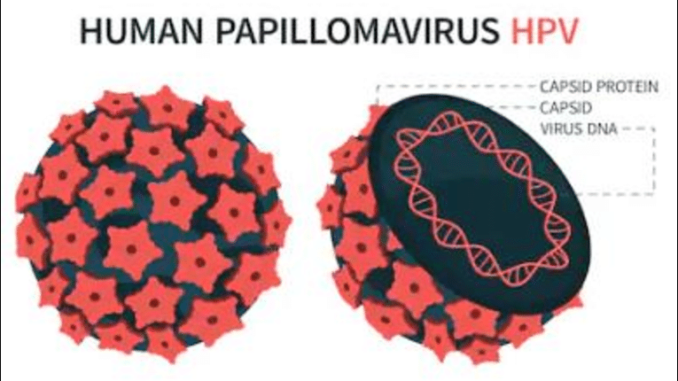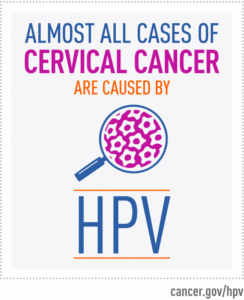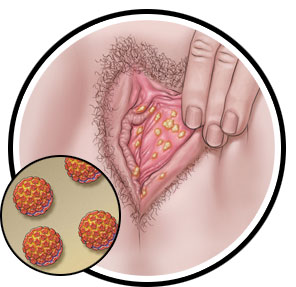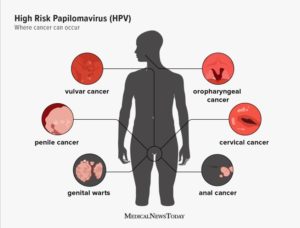
Table of Contents
What is Human Papilloma Virus (HPV)?
- Human papilloma virus (HPV) is a viral infection that’s passes between people through skin-to-skin contact.
- Human Papilloma Virus (HPV) is the name of a virus family that is quite common. Most people remain unaffected with this virus, but other some types can result in genital warts or cancer.
(Genital warts are soft growths that appear on the genitals. They are Sexually Transmitted Infections and can cause pain, discomfort, and itching.)
- Human Papilloma Virus (HPV) is also one of the most common Sexually Transmitted Illness (STI).
- HPV infection is a virus that creates growths on the skin or mucous membranes (warts). Human papillomavirus (HPV) has over 100 different varieties. Some HPV infections create warts, while others can lead to other cancers.
- The majority of HPV infections do not result in cancer. However, some strains of genital HPV can develop cancer of the lower uterus, which connects to the vaginal opening (cervix).
- Other cancers, including as cancers of the anus, penis, vagina, vulva, and back of the neck, have been linked to HPV infection (oropharyngeal).
- It usually spreads through sexual contact or other forms of skin-to-skin contact.
Key Facts About Human Papilloma Virus (HPV)
- Human Papilloma Virus (HPV) is the most common sexually transmitted infection (STI) in the United States.
- Nearly half of all high-grade cervical pre-cancers are caused by two human papilloma virus types (16 and 18).
- HPV is mostly transmitted through sexual contact, and the majority of persons become infected with HPV shortly after sexual activity begins. More than 90% of them recover from the virus eventually.

- HPV prevents against cervical cancer in females
- Cervical cancer can be prevented at a low cost by vaccinating against HPV and screening and treating pre-cancer lesions.
- HPV will infect 80% of unvaccinated individuals at some point in their lives. Because it has no symptoms in most people (you won’t know you have it), it is unavoidably spread through sexual (including oral) skin-to-skin contact.
- Oropharyngeal (throat) cancer is more common in men, and the HPV vaccine can help protect against it.
- HPV vaccines do not treat HPV infection, and there is no cure for the virus at this time.
- Because the vaccine does not protect against all HPV types, vaccinated women should continue to get Pap exams on a regular basis.
Transmission of Human Papilloma Virus (HPV)
- The virus infects when it enters body by a cut, abrasion, or a small tear in skin. The most typical way for the virus to spread is through skin-to-skin contact.
- Sexual contact, anal sex, and other skin-to-skin contact in the genital region are all ways to develop genital HPV infections.
- Oral intercourse is the source of some HPV infections that cause oral or upper respiratory lesions.
- Warts can be transmitted from one person to the next. When people come into contact with a wart, it’s possible that it will spread. Warts can also spread if someone comes into contact with something that has already been touched by a wart.
- It’s likely that if you’re pregnant and have an HPV infection with genital warts, your kid will get the virus.
Symptoms of Human Papilloma Virus (HPV)

In 90% of the cases, HPV usually does not cause any noticeable symptoms or health problems. An HPV infection is usually defeated by body’s immune system before it causes warts.
However, when the virus does not go away, it can show some symptoms like:
- Genital warts
- Warts in the throat
- Cervical cancer
- Cancer of the genitals, head, neck and throat
- Emergence of warts is major symptoms of HPV infections. Their appearance varies depending on which type of HPV is present
- Warts can be genital, common, flat or plantar
Diagnosis of Human Papilloma Virus (HPV)
- A person’s “HPV status” cannot be determined by a test. Furthermore, there is no FDA-approved HPV test for detecting HPV in the mouth or throat.
- Cervical cancer can be detected using HPV testing.
- Men, adolescents, and women under the age of 30 should not be screened with HPV testing.
- The majority of HPV-infected people are completely unaware of their infection. Patients may find they have HPV when they acquire genital warts.
- When a woman has an abnormal Pap test result, she may discover she has HPV (during cervical cancer screening). Others may only learn after they’ve had more significant HPV-related issues, such as cancer.
Health Problems Related to HPV
- The human papilloma virus is responsible for the vast majority of cervical cancer cases (more than 95 percent).
- The most common HPV-related illness is cervical cancer. HPV infection is responsible for nearly all occurrences of cervical cancer.
- Although most HPV infections and pre-cancerous lesions disappear on their own, there is a risk that HPV infection will become chronic and pre-cancerous lesions may precede to invasive cervical cancer in all women.
- In women with a healthy immune system, cervical cancer takes 15 to 20 years to develop. In women with compromised immune systems, such as those with untreated HIV infection, it can take as little as 5 to 10 years.

Preventive Measures for Human Papilloma Virus (HPV)
- Using condoms and practicing safe sex are the easiest ways to avoid HPV.
- Additionally, a vaccine for the prevention of genital warts and cancers caused by HPV is available. The vaccine can protect against HPV, which has been linked to cancer and genital warts.
- The HPV vaccine is recommended by the Centre for Disease Control and Prevention (CDC) for boys and girls aged 11 to 12. The vaccine is administered in two doses, at least six months apart. Women and men between the ages of 15 and 26 can also get vaccinated in three doses.
- Additionally, persons aged 27 to 45 who have never been vaccinated against HPV are now eligible for immunization.
- Getting frequent health checks, screenings, pap smears and vaccinations to avoid HPV-related health concerns.
Vaccine for HPV
- At the moment, World Health Organization (WHO) has prequalified four vaccines, all of which protect against HPV strains 16 and 18, which are known to cause at least 70% of cervical malignancies
- The 9-valent vaccine also protects against five more oncogenic HPV strains, which are responsible for 20% of cervical malignancies
- HPV types 6 and 11, which produce anogenital warts, are also protected by two of the vaccines.
- HPV vaccines perform best when given before being exposed to HPV. As a result, the WHO recommends vaccination girls between 9 to 14 years old, when the majority of them have not begun sexual activity, to avoid cervical cancer.
- Some countries have begun to vaccinate boys in the hopes of preventing HPV-related malignancies in both men and boys.
- To minimize cervical cancer incidence and fatalities in areas where the HPV vaccine has been introduced, population-based screening programs are needed to diagnose and treat cervical pre-cancer and cancer.
References and For More Information
https://www.who.int/news-room/fact-sheets/detail/cervical-cancer
https://www.cdc.gov/std/hpv/stdfact-hpv.htm
https://www.medicalnewstoday.com/articles/246670
https://www.nhs.uk/conditions/human-papilloma-virus-hpv/
https://www.mayoclinic.org/diseases-conditions/hpv-infection/symptoms-causes/syc-20351596
https://pubmed.ncbi.nlm.nih.gov/33538338/
https://www.ncbi.nlm.nih.gov/pmc/articles/PMC3038604/
https://www.healthlink.news/hpv-vaccine-what-you-need-to-know/
https://www.healthline.com/health/human-papillomavirus-infection#symptoms
https://www.cdc.gov/std/hpv/stdfact-hpv.htm
https://www.mayoclinic.org/diseases-conditions/hpv-infection/symptoms-causes/syc-20351596